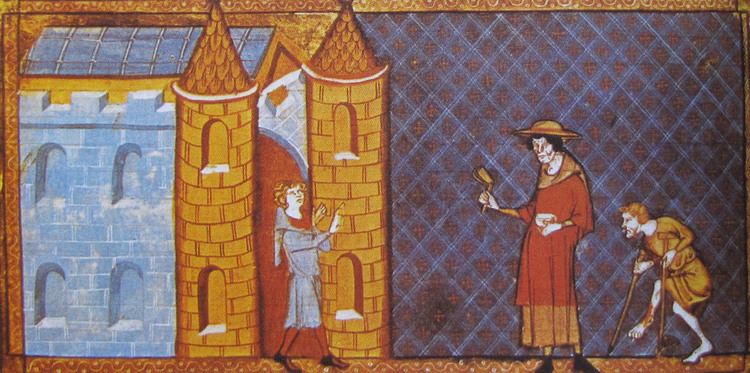 | ||
The 1321 leper scare (also known as the lepers' plot) was an alleged conspiracy of French lepers to spread their disease by contaminating well water with their powders and poisons. Lepers were the most abused people during the Middle Ages according to the American Jewish historian Solomon Grayzel; they were thrown out of settlements and treated as wild animals due to the widespread belief that the disease was highly contagious. Jews and Muslims were said to be implicated in the plot, providing an excuse for local authorities to attack both Jewish and leper communities. The hysteria quickly spread to the neighbouring realms, most notably to the Kingdom of Aragon.
Contents
France
The rumours of the conspiracy broke out in the spring of 1321 and terrified the people of southern France. Torture of lepers ensued, and eventually a confession was forced out, stating that the lepers were acting on the orders of Jews, who in turn had been bribed by the Muslims of Spain, in an attempt to "poison the Christian population of Europe". The scare flourished in the wake of the previous year's Shepherds' Crusade, which saw young rural men and women form a mob and attack Jews in France and the neighbouring Kingdom of Aragon, despite being ordered to stop by Pope John XXII, King Philip V of France and King James II of Aragon. Already in 1320, some of the apprehended and later hanged "crusaders" claimed to have found barrels filled with rotten bread while pillaging a leper colony (possibly near Le Mas-d'Agenais), and made a strikingly uncommon accusation, alleging that the lepers had intended to use the bread to prepare poisons for contaminating well water. The rumours that sparked the violence in 1321 may have started here. While the Shepherds' Crusade was led by rioters, the persecution of lepers was orchestrated by municipal authorities, making it judicial though extralegal (judicial power being royal prerogative).
King Philip was on a tour of the region when the stories started circulating. He found himself in a difficult position; he could openly neither condone nor condemn the unstoppable persecution, as the former would have led to more violence, while the latter would have undermined his authority. The Dominican inquisitor Bernard Gui was instructed to conduct extensive investigation. On 21 June, Philip ordered by edict that all lepers be imprisoned and examined under torture. Those found guilty were to be burnt at the stake. Since their crimes were declared lèse-majesté, the lepers' property was to be confiscated by the Crown, but this decision was successfully defied by his vassals.
Aragon
News of the uncovered plot spread rapidly to the neighbouring countries. King James learned of the supposed conspiracy and associated violence almost immediately. James's cousin, King Sancho of Majorca, informed him of the situation in France by a letter dated 2 June, but James deliberated for nearly a week. The French lepers fleeing the "lash of justice", as James put it in a letter to his officials, were already seeking shelter in his realm. He cautiously commanded the arrest and expulsion of all leprous foreigners, while Jews were not mentioned. By 27 June, James had changed his mind in favour of a harsher approach. He ordered not only the seizure of the diseased, destruction of their powders, and questioning under torture, but also the arrest and expulsion of non-leprous foreigners, "since it is difficult, truly even impossible, to recognize such and identify them". Local inquisitions were set up in Manresa, Ejea de los Caballeros, Huesca, Montblanc, Tarazona and Barcelona. Those who confessed were burnt. Leper colonies were attacked and their goods seized, including the ancient leprosarium attached to the Church of Santa Maria de Cervera.
A suspected leper was most likely examined and diagnosed with the disease by frightened lay people rather than experienced physicians. A year after the scare, a physician called Amonant decided to move from Gascony to Aragon, only to be apprehended in Huesca and accused of being a leper intending to poison the water. The physician appealed to King James's son Alfons and was granted examination by local physicians, who confirmed that he was not infected. Frightened, he chose to nevertheless leave Aragon. The incident was probably one of many that helped promote medical diagnosis of leprosy.
